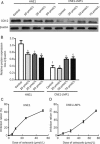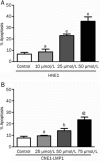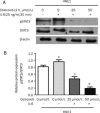Celecoxib induces apoptosis and cell-cycle arrest in nasopharyngeal carcinoma cell lines via inhibition of STAT3 phosphorylation
- PMID: 22504904
- PMCID: PMC4010355
- DOI: 10.1038/aps.2012.18
Celecoxib induces apoptosis and cell-cycle arrest in nasopharyngeal carcinoma cell lines via inhibition of STAT3 phosphorylation
Erratum in
- Acta Pharmacol Sin. 2013 Apr;34(4):581
Abstract
Aim: To investigate the mechanisms underlying the anticancer effect of celecoxib on nasopharyngeal carcinoma (NPC).
Methods: NPC cell lines, HNE1 and CNE1-LMP1, were treated with various concentrations of celecoxib for 48 h. The antiproliferative effect of celecoxib was assessed using MTT assay. Both cell cycle profiles and apoptosis were analyzed using flow cytometry. Western blot was used to measure the levels of signal transducer and activator of transcription 3 (STAT3), phosphorylated STAT3(Y705) (pSTAT3(Y705)), COX-2, Survivin, Mcl-1, Bcl-2 and Cyclin D1.
Results: Celecoxib (10-75 μmol/L) inhibited the proliferation of the NPC cell lines in a dose-dependent manner. Celecoxib (25 and 50 μmol/L) induced apoptosis and cell-cycle arrest at the G(0)/G(1) checkpoint in the NPC cell lines, which was associated with significantly reduced STAT3 phosphorylation. The genes downstream of STAT3 (ie, Survivin, Mcl-1, Bcl-2 and Cyclin D1) were significantly down-regulated after exposure to celecoxib (25 and 50 μmol/L).
Conclusion: The anticancer effects of celecoxib on NPC cell lines results from inducing apoptosis and cell cycle arrest, which may be partly mediated through the STAT3 pathway.
Figures





Similar articles
-
Anticancer effects of celecoxib through inhibiton of STAT3 phosphorylation and AKT phosphorylation in nasopharyngeal carcinoma cell lines.Pharmazie. 2014 May;69(5):358-61. Pharmazie. 2014. PMID: 24855827
-
Stat3 inhibitor Stattic exhibits potent antitumor activity and induces chemo- and radio-sensitivity in nasopharyngeal carcinoma.PLoS One. 2013;8(1):e54565. doi: 10.1371/journal.pone.0054565. Epub 2013 Jan 29. PLoS One. 2013. PMID: 23382914 Free PMC article.
-
Celecoxib enhances radiosensitivity via induction of G₂-M phase arrest and apoptosis in nasopharyngeal carcinoma.Cell Physiol Biochem. 2014;33(5):1484-97. doi: 10.1159/000358713. Epub 2014 May 9. Cell Physiol Biochem. 2014. PMID: 24854838
-
Celecoxib and Bcl-2: emerging possibilities for anticancer drug design.Future Med Chem. 2012 Mar;4(3):361-83. doi: 10.4155/fmc.11.177. Future Med Chem. 2012. PMID: 22393942 Free PMC article. Review.
-
The efficacy of natural products for the treatment of nasopharyngeal carcinoma.Chem Biol Drug Des. 2024 Jan;103(1):e14411. doi: 10.1111/cbdd.14411. Epub 2023 Dec 11. Chem Biol Drug Des. 2024. PMID: 38073436 Review.
Cited by
-
Clinicopathological and prognostic significance of cyclooxygenase-2 expression in head and neck cancer: A meta-analysis.Oncotarget. 2016 Jul 26;7(30):47265-47277. doi: 10.18632/oncotarget.10059. Oncotarget. 2016. PMID: 27323811 Free PMC article.
-
Inhibition of STAT3 acetylation is associated with angiotesin renal fibrosis in the obstructed kidney.Acta Pharmacol Sin. 2014 Aug;35(8):1045-54. doi: 10.1038/aps.2014.42. Epub 2014 Jun 30. Acta Pharmacol Sin. 2014. PMID: 24976155 Free PMC article.
-
P300-dependent STAT3 acetylation is necessary for angiotensin II-induced pro-fibrotic responses in renal tubular epithelial cells.Acta Pharmacol Sin. 2014 Sep;35(9):1157-66. doi: 10.1038/aps.2014.54. Epub 2014 Aug 4. Acta Pharmacol Sin. 2014. PMID: 25088002 Free PMC article.
-
Human cytomegalovirus IE1 protein disrupts interleukin-6 signaling by sequestering STAT3 in the nucleus.J Virol. 2013 Oct;87(19):10763-76. doi: 10.1128/JVI.01197-13. Epub 2013 Jul 31. J Virol. 2013. PMID: 23903834 Free PMC article.
-
Tonglian Decoction () arrests the cell cycle in S-phase by targeting the nuclear factor-kappa B signal pathway in esophageal carcinoma Eca109 cells.Chin J Integr Med. 2016 May;22(5):384-9. doi: 10.1007/s11655-016-2096-3. Epub 2016 Mar 5. Chin J Integr Med. 2016. PMID: 26946149
References
-
- Yu MC, Yuan JM. Epidemiology of nasopharyngeal carcinoma. Semin Cancer Biol. 2002;12:421–9. - PubMed
-
- Agulnik M, Epstein JB. Nasopharyngeal carcinoma: current management, future directions and dental implications. Oral Oncol. 2008;44:617–27. - PubMed
-
- Teo PM, Kwan WH, Lee WY, Leung SF, Johnson PJ. Prognosticators determining survival subsequent to distant metastasis from nasopharyngeal carcinoma. Cancer. 1996;77:2423–31. - PubMed
-
- Zhang M, Xu ZG, Shi Z, Shao D, Li O, Li W, et al. Inhibitory effect of celecoxib in lung carcinoma by regulation of cyclooxygenase-2/cytosolic phospholipase A2 and peroxisome proliferator-activated receptor gamma. Mol Cell Biochem. 2011;355:233–40. - PubMed
Publication types
MeSH terms
Substances
LinkOut - more resources
Full Text Sources
Molecular Biology Databases
Research Materials
Miscellaneous

